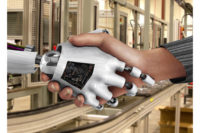Cordless tool manufacturers and their battery suppliers are focusing part of their R&D efforts on recharging technology. As a result, today's battery chargers are faster and smarter than ever.
With each advance in cell material, charging technologies have also progressed to be able to manage the charging cycle more efficiently. “The transition to nickel-metal hydride and lithium-ion batteries over time has necessitated technology improvements in recognizing individual environmental factors in order to maximize charging productivity,” says Steve Tayler, vice president of business development for aerospace and assembly at Makita USA Inc. (La Mirada, CA).
Today’s lithium-ion cells feature high discharge rates are also capable of higher charge rates. In some cases, this has offered manufacturers an opportunity to dramatically shorten charge times from hours to minutes.
“However, it should be pointed out that recharging a single cell in 15 minutes or less is one thing,” warns Chris Turner, director of battery technology at Nexergy Inc. (Columbus, OH), a battery pack systems integrator that works with several different battery cell manufacturers and tool manufacturers. “To realize this benefit in a multi-cell battery pack requires beefing up the device and battery electronics, and dealing with issues related to heat management. In addition, it requires a significantly larger charger capable of delivering the power necessary to recharge in this amount of time.
“This leads to significant additional costs for the device manufacturer that has to be balanced against the benefit of the quicker recharge time in the market,” adds Turner. “While everyone would like to have a battery that recharges in 15 minutes or less, how much someone is willing to pay for that is evidently another matter.”
The need to manage heat build-up and safe charging practices have spurred manufacturers to develop smart charging systems that recognize battery conditions. Some of the most advanced power systems on the market now feature batteries with integrated microprocessors that sense cell condition and communicate it to the charger.
The charger reads the battery and optimizes its charge based on the information it receives, improving battery performance and longevity. In addition, the charger automatically detects battery voltage and chemistry, choosing the correct charge algorithm. This enables operators to use the same charger for multiple voltages and chemistries.
“Some manufacturers now produce chargers with ‘renew’ capabilities, as well,” says Christian Corrigan, global marketing manager for cordless tools at Ingersoll Rand Productivity Solutions (Annandale, NJ). “These chargers force the battery to completely discharge and recharge every time, giving the battery a deep cycle refresh and restoring it to like-new condition.”
The charger also calibrates battery electronics. “For nickel-cadmium batteries, this feature eliminates memory effect, significantly extending usable battery life and decreasing the number of replacement batteries over the life of the tool,” explains Corrigan.
Some advanced chargers are able to identify individual environmental characteristics like temperature, internal resistance, number of charging cycles, number of partial charges and individual ID recognition in an effort to maximize both the individual run time per charge and total number of cycles over the life of the product.
Tayler says his company’s charging systems are designed for two primary objectives: To maximize the individual efficiency of each charge and to extend the overall life cycle expectations of the battery. “This is done through monitoring battery conditions throughout the charge cycle and differentiating between hot or overloaded batteries and cold batteries,” he points out
Charging Technology Gets Smarter, Faster
Looking for a reprint of this article?
From high-res PDFs to custom plaques, order your copy today!




